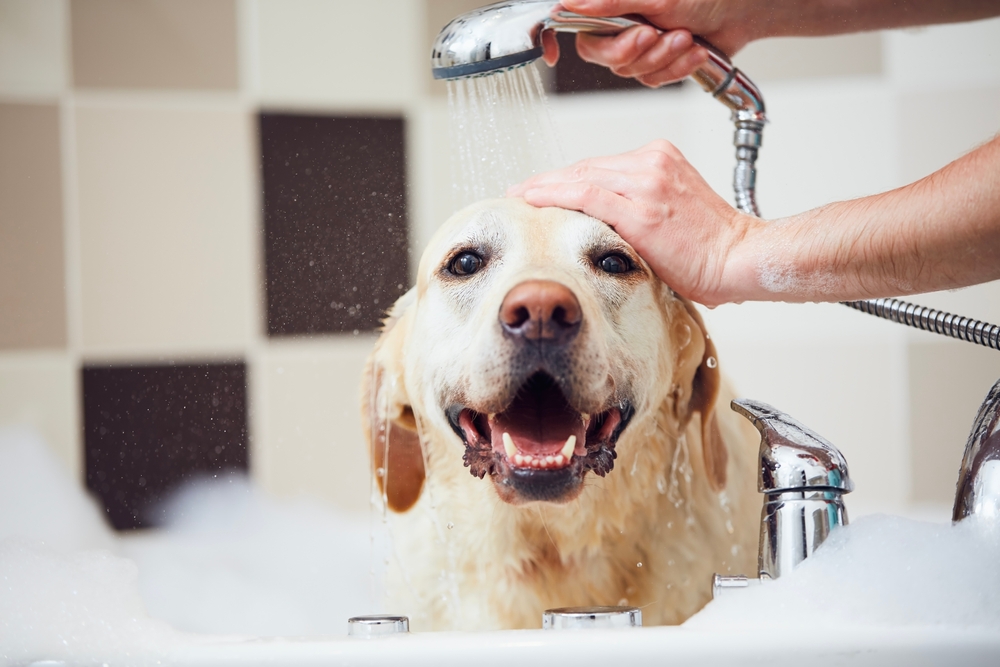Pet allergies are a common issue that can lead to persistent skin problems, discomfort, and even secondary infections. At Willow Wood Animal Hospital, we’re here to help you understand how to manage and treat these skin conditions, ensuring your pet stays as comfortable and healthy as possible. Allergies in pets are usually chronic, meaning that while they may not be fully curable, they are certainly manageable. With the right approach, you can minimize flare-ups, reduce discomfort, and improve your pet’s quality of life.
Understanding Skin Disease in Pets
1. Chronic but Manageable
Skin diseases, often caused or exacerbated by allergies, are typically chronic conditions. For most pets, the goal of treatment is not a complete cure but rather long-term symptom management. With consistent treatment, you can effectively control symptoms like itching, redness, and inflammation, helping your pet feel more comfortable.
2. Identifying Underlying Causes
Determining the root cause of your pet’s skin allergies can be challenging. Allergies may stem from:
– Environmental Factors: Pollens, dust mites, and molds can trigger allergic reactions, particularly during certain seasons.
– Food Allergies: Some pets are sensitive to certain proteins or ingredients, leading to skin issues.
– Flea Allergies: For many pets, even a single flea bite can cause an allergic reaction, triggering intense itching and irritation.
In some cases, the exact cause remains unknown, which is why we focus on symptom management and routine care. If you’re interested in learning more about specific allergies and common chronic issues, like chronic ear infections in dogs, our team can provide additional resources and personalized advice.
3. Watch for Secondary Infections
When pets continuously scratch, lick, or bite affected areas, they risk developing secondary infections. Bacterial or yeast infections can worsen skin conditions, making your pet even more uncomfortable. Treating these infections alongside allergies is crucial for successful skin management. Veterinary treatments may include ointments, medicated shampoos, wipes, or antibiotics, helping clear infections so other treatments can work more effectively.
Treatment Options for Managing Pet Allergies
With a variety of treatment options available, pet allergy management can be tailored to suit both your pet’s needs and your lifestyle.
Topical Therapy
Topical products applied directly to your pet’s skin help reduce symptoms and address flare-ups. These treatments are especially useful because they work on the skin’s surface, where the allergic reactions manifest. Some commonly used topical therapies include:
- Shampoos: Medicated shampoos help cleanse the skin, remove allergens, and soothe inflammation. Routine bathing can reduce itchiness and restore the skin barrier. Depending on your pet’s condition, a weekly bath with medicated shampoo may be recommended. For tips on home grooming, check out our guide to grooming your pet at home.
- Mousses and Wipes: These are convenient for targeting specific areas of the body, such as paws or belly. Wipes are easy to use on the go and can be applied between baths to keep skin clean.
- Sprays: Topical sprays are helpful for covering larger areas or treating hot spots. They provide quick relief and are easy to apply.
Remember, after applying any topical treatment, prevent your pet from licking it off immediately. Consider using treats, toys, or playtime to distract them while the product absorbs.
Medications for Itch Relief and Inflammation
For pets with moderate to severe itching, medications can be beneficial:
- Apoquel: This oral tablet provides itch relief and is effective for allergic itching, though it may not address underlying inflammation.
- Cytopoint: This injection offers itch relief for 4-8 weeks by targeting the proteins that trigger itching, making it a convenient option for pets with chronic itchiness.
- Omega-3 Fatty Acids: Supplements like Welactin, Free Form Snip Tips, or Nordic Naturals contain anti-inflammatory properties, promoting healthier skin and reducing inflammation.
Medications are often combined with topical treatments to provide comprehensive relief. If your pet has ongoing skin issues, consult with our veterinarians to determine the best combination of treatments.
Flea Control and Environmental Treatment
For pets with flea allergies, strict flea control and managing the home environment are essential. Regular use of high-quality flea preventatives helps protect pets from flea bites that can trigger allergic reactions. Additionally, keeping your home clean with regular vacuuming, washing bedding, and treating outdoor areas for fleas can further reduce the risk of exposure and help manage your pet’s allergies.
Advanced Allergy Management: Food Trials, Allergy Testing, and Hyposensitization
For pets who don’t respond well to initial treatments, or when the cause of allergies remains unclear, further diagnostic steps can be taken.
Food Trials for Identifying Food Allergies
If food allergies are suspected, a food trial is often recommended. This involves feeding your pet a novel protein or hydrolyzed diet—one they haven’t previously been exposed to—for a period of 8-12 weeks. During the trial, avoid giving any treats or table scraps, as these could interfere with the results. If your pet’s symptoms improve on the trial diet, it suggests a food allergy is likely. Food trials can be highly effective in identifying specific food triggers and are an essential tool for managing food-related allergies.
Allergy Testing and Hyposensitization
In cases where environmental allergies are suspected, allergy testing may be conducted. This testing can identify specific environmental allergens like pollen, dust mites, and molds. Based on the results, hyposensitization therapy (or allergen-specific immunotherapy) may be recommended. This involves gradually introducing small doses of the allergen to build up your pet’s tolerance. It’s a long-term solution that can significantly reduce allergic reactions in some pets, making it a valuable treatment for pets with chronic environmental allergies.
Referral to a Veterinary Dermatologist
If your pet’s allergies remain difficult to control or if they require specialized care, a referral to a veterinary dermatologist may be beneficial. Veterinary dermatologists have advanced training in diagnosing and managing complex skin conditions, and they can provide additional options that may not be available in general practice.
Making Allergy Treatment Work for Your Routine
Managing a pet with allergies requires a balance of effective treatment and realistic routines. Here are some tips for integrating treatment into your lifestyle:
- Bathing Tips: Bathing helps remove allergens and soothe irritated skin. If your pet has sensitive skin, weekly bathing with a gentle medicated shampoo may be recommended. In cases of flare-ups, more frequent baths, even twice a week, can help.
- 10-Minute Wait with Medicated Shampoos: For medicated shampoos to work effectively, they should stay on the skin for about 10 minutes before rinsing. Distract your pet with a puzzle toy, walk, or gentle play to help pass the time.
- Consistent Use of Topicals: Using mousses, sprays, or wipes regularly can help keep specific problem areas clean and protected. Be mindful to prevent licking immediately after application.
Building Positive Associations with Treatment
If your pet is anxious or uncooperative with treatments, use positive reinforcement to make it a better experience. Start by gently touching areas like paws and ears when they are healthy, so your pet associates these touches with something positive. You can also:
- Use treats or a lick mat during bath time.
- Slowly introduce them to the routine, reinforcing good behavior with rewards.
Realistic Goals and Lifestyle Adjustments

Finding a sustainable routine for managing your pet’s skin health is key. You don’t have to follow an intensive regimen if it’s not feasible; aim for what works best within your daily schedule. Adjustments may include:
- Regular Maintenance: Weekly baths with calming shampoos can help maintain healthy skin, while more frequent baths during flare-ups may be needed.
- Seasonal Adjustments: During spring and summer, when pollen counts are high, increase baths or wipe-downs to remove allergens from the skin.
Protecting the Skin Barrier
Topical products like mousse and wipes are essential for keeping your pet’s skin barrier strong. They help prevent infections and flare-ups, minimizing the need for long-term antibiotics. Over-bathing can be a concern, but high-quality products designed to protect the skin barrier allow for frequent bathing without drying or irritating the skin.
Important Reminders for Allergy Management
When dealing with allergies, it’s crucial to be patient and persistent. Skin conditions in pets often require ongoing attention and adjustments to ensure their comfort. Remember:
- Be Observant: Note any changes in your pet’s skin or behavior and communicate them to your vet.
- Consistency Matters: Regular use of topical products and a balanced routine can reduce the frequency and severity of allergy flare-ups.
If you’re unsure about any aspect of your pet’s allergy management, don’t hesitate to ask our team at Willow Wood Animal Hospital. Meet our dedicated team who are here to support you in providing the best possible care for your pet’s unique needs.
Schedule an Appointment with Willow Wood Animal Hospital
If you’re concerned about your pet’s skin health or need guidance on allergy management, schedule an appointment with our team. We can provide a personalized treatment plan to address your pet’s specific needs and help them live more comfortably. For more information, reach out to us at Willow Wood Animal Hospital.







Leave A Comment